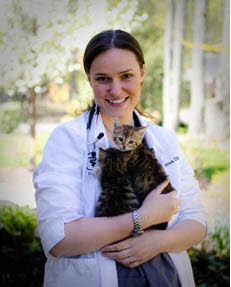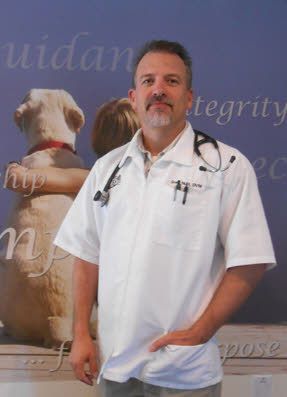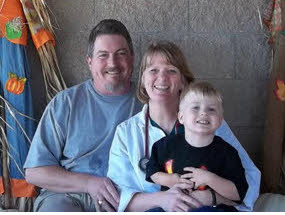
Photo courtesy of Wintergreen Animal Hospital
Dr. Amanda Jones enjoys the variety of cases found in her work as a general practitioner.
"In a given day, we (veterinarians) are a pediatrician, a dermatologist, a cardiologist, an internist, a surgeon, a radiologist, an anesthesiologist, a psychiatrist and a funeral service all in one!” wrote Dr. Amanda Jones, of Erie, Pa., on a message board of the Veterinary Information Network (VIN). ”And some of us are also managers, bookkeepers, and human resources directors, too!"
Altered from its origins in farm animal practice, veterinary medicine has shifted from carthorses and farm animals to family pets. The profession’s demographics have changed as well. Women far outnumber men in veterinary schools, and specialization in fields such as cardiology and oncology, once rare, is commonplace. However, for most veterinarians, one aspect of a life spent treating animals remains the same: No two days are alike, considering the varied roles encompassed by general practitioners, or GPs as they're commonly called.
While physicians tend to have the same cases all day, Jones observed that veterinarians handle different species, all types of problems, emergencies, imaging and surgeries. On VIN, an online community for the profession, she pointed out that even veterinary specialists focus on a comparatively small number of animal health problems and procedures.
The vast array of subjects and procedures a veterinarian is called to tackle in a single shift can be overwhelming. But never knowing what the day will bring is what Jones likes best about her work. She likes having to think through an unusual situation or getting creative with a treatment because of circumstances. Jones noted that some of her work days are surreal when euthanasia is followed by the excitement of checking a new puppy. She expressed enthusiasm when recalling the day she castrated a pot-bellied pig and gave chemotherapy to a dog with bone cancer.
"I do try sometimes to give my husband and friends an idea of what a typical day is like," Jones wrote, "and I can never seem to paint the picture. There's just so much going on all the time. On the rare times that my husband drops by the clinic he usually looks like a deer in the headlights."
Gender shift
That fact that Jones' husband isn't the veterinarian on duty speaks to a relatively new phenomenon. For more than 200 years, men dominated veterinary medicine.
Starting in the mid-1980s, the profession's demographics began to change. Today, women comprise half of America's veterinary workforce and nearly 80 percent of new graduates. The Center for Health Workforce Studies projects that by 2030, men will make up just 30 percent of the profession.
The gender shift raises new issues and disparities in veterinary medicine.

Photo courtesy of Catherine Heck
Dr. Greg Nutt credits female veterinarians for the profession's attention to balancing work and life.
Some veterinarians believe the profession benefits from a growing female population. While Dr. Greg Nutt of Canton, Ga., doesn't credit either gender with any greater technical competency, he thinks female veterinarians often bring more empathy to practice. Women in the profession also have ushered in an expectation of a balance between work and outside interests, he said.
“The generation before, those guys put in 70, 80, or 90 hours a week and expected that from their employees,” Nutt said. “Women brought out an awareness that we have outside responsibilities, too; we don't have to work those hours.”
Despite roughly 100 years of American feminism, a 2013 report from the American Veterinary Medical Association (AVMA) reveals that female veterinarians earn less than their male counterparts. In 2011, the median income of female associates in companion exclusive private practice was $88,000 compared with $100,000 for male associates. For practice owners, women reported a median income of $100,000 — $60,000 a year less than male owners.
The AVMA data is based on a relatively small, non-randomized, self-reported sample and may not represent the workforce as a whole, but more comprehensive data does not exist. Why such salary discrepancies seem to exist is not well understood.
Dr. Gailene Holland of Lugoff, S.C., wonders if the earnings gap stems from an outdated idea that women aren't household breadwinners and, therefore, should be paid less.
"That (disparity) is a negative," Holland said. "As a whole, the profession seems to be struggling with the financial aspect and women not being paid as much as men. I make an adequate — not stellar — salary. When I became a mom that changed a lot of things. I used to be very aggravated (about the disparity), but now my energy is directed elsewhere. “
Holland doesn’t want to believe that practice owners might bank on women turning their focus toward their children, as she has done, to save on salaries. That said, she wouldn’t be surprised if some male employers considered it.
Dealing with specialists
Owners might have good reason to hold back on salaries given competition from a growing number of veterinary practices, especially those offering specialty care.
Years ago, veterinary specialists were rare. That began to change in the 1990s, when more newly minted veterinarians put off private practice in order to further their education in specialty areas.
Today, the AVMA reports that roughly 11,000 veterinarians in the country are board-certified in one or more specialty. The increased availability of specialty medicine is viewed by many to be a mixed blessing; for all of the benefits tied to advanced care, specialists can strip general practices of business and interesting cases.
Holland sums it up this way: "I adore my local specialists; they seem to value us. They almost always are supportive, and we have good working relationships. However, there are a fair number of specialists that are in an ivory tower and have no clue what it's like to be a general practitioner. Early on when I was green I would get harsh remarks and unrealistic recommendations from specialists.”
Holland refers clients to specialists about once or twice a month, and not without notifying owners that such care typically comes at a higher price. The last two clients she referred declined any workup at the specialty practice due to the expense.
Nutt has found specialist referrals to be a useful tool for handling difficult clients.
“There are many times that GPs refer just because we don't feel knowledgeable enough, sometimes because we are at wit's end, or they're not following our recommendations,” Nutt said. He surmises that some clients might perceive specialty care to be more valuable due to its price tag. If owners pay more for specialty care, he said, they might be more inclined to follow the specialist's directions.
Dr. Mark Rishniw spent a few years working as a general practitioner before embarking on board certification in cardiology and small animal internal medicine. He offers a unique perspective on the different styles of practice.
"General practice was incredibly rewarding," he wrote in a VIN message board discussion. "You had a continuity of cases, you had clients who became friends, you were part of a local community. All these things disappear with specialization (for the most part). My knowledge ... has become a mile deep and an inch wide. As a mixed-practice GP, it was the opposite.”
Rishniw, who now works at VIN as director of clinical research and is a visiting scientist at Cornell University's veterinary college, chose to specialize because he didn't like sometimes feeling mediocre in practice due to the ever-widening scope of knowledge and skills expected of general practitioners. He wanted to hone his skills in one or two disciplines.
"In specialization, you get a different degree of variety because you tend to see more complexity," Rishniw said. "You get the time to ask and answer questions about physiology or clinical questions that can be addressed by studies."
The business of practicing
Another challenge many general practitioners face is the business end of owning a practice. It's not a role Nutt enjoys. He'd rather be interacting with and treating patients.
Even so, he's turned his attention to the topic, especially now that economic conditions in America are flat.

Photo courtesy of Brian Spilker
Dr. Gailene Holland, pictured with her family, is bothered that pay in her profession seems to have a gender bias.
Holland dislikes the business end so much that when she had an opportunity to buy her previous employer's practice, she declined.
Jones, an associate, is responsible for inventory management, hiring and payroll. She used to wonder why the practice charged so much for a bandage. Now that she understands how the business operates, she wonders why they don't charge more.
Given the variety of patients seen by general practitioners, they often develop favorites and ones they dread. Jones loves the adrenalin rush of emergencies but dislikes dealing with unsocialized dogs. Holland excels at basic wound care but said she gets frustrated with the diagnostics required to work up some cases. She dreads when she sees an animal with a treatable condition that isn't dealt with due to cost or an owner's apathy.
“I had to learn I cannot care more for their pet than they do,” Holland said of such cases.
Some of Nutt's favorite clients are those struggling to pay their bills because he knows they are making an effort and their pet is a priority.
"We can work with people who can't afford things," Nutt said. "We can work within their budget to at least do some good."
Jones said that some owners can be testy, especially in an uncertain economy. She sometimes has to argue for every test or procedure she feels is necessary but ends up guessing on diagnoses and treatments, hoping for the best. But she places clients who cannot afford treatments in a different category from owners who are rude, abusive, non-compliant or try to avoid paying the bill at checkout.
"It honestly depends on my mood as to how well I handle difficult clients," Jones said. "I know I'm burned out and need a vacation when I can't deal with them at all.”
New challenges
Competitors seem to spring up regularly. Humane societies with clinics, low-cost spay/neuter and vaccine clinics, online pharmacies and big box retail stores all compete with private practitioners for business. New graduates face student debt loads that often are two to three times their starting salaries. Most veterinarians earn far less than is assumed by the general public, including their clients.
The profession's biggest obstacle, Nutt mused, is that it lacks direction and guidance on how to address outside challenges. Veterinarians, he said, are not well positioned or prepared to fight major corporations that use media to paint them in a negative light. One example are the televised advertisements for online pharmacies, implying that veterinarians overcharge for pet medications. Another is the recent and widely criticized 20/20 exposé that suggests veterinarians prey on pet owners in order to turn a profit.
However sensational or ridiculous, he said, such allegations erode the profession's value and make it harder for veterinarians to practice good medicine.
“I didn't expect it to be as much of a financial struggle to practice, to recommend and do what I think is best for the pet,” Nutt said. “I was a firm believer that you do what you love and do it as best you can, and it will work itself out. That was probably a little naive. Sometimes the differences between peaks and valleys are bigger than what I thought they'd be. But the highs as far as getting to know people and the non-financial benefits can be much greater than you could expect.”
He can't imagine working in any other profession.
